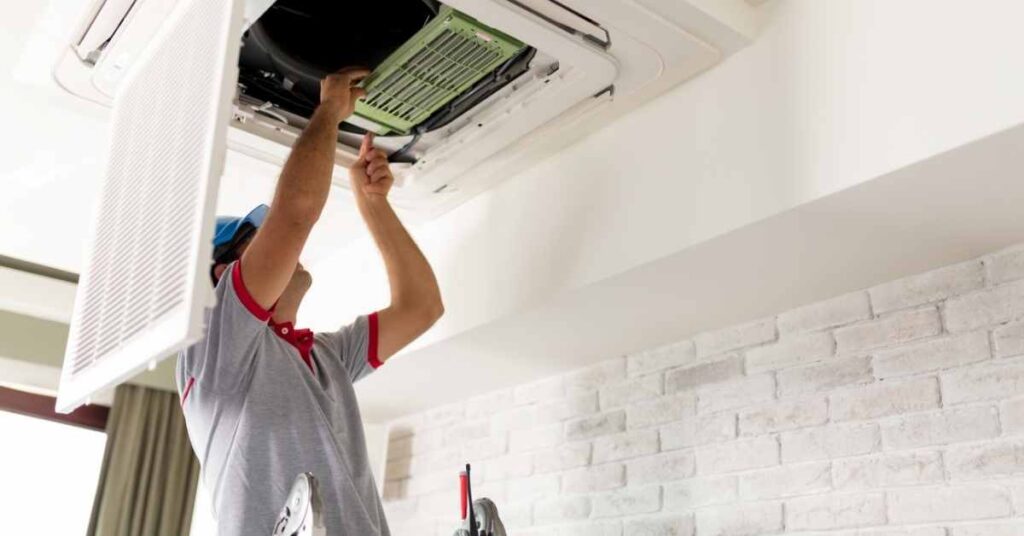If you’re needing AC Repair in Plano, there are some solutions to common air conditioner issues you can try to do yourself. If you attempt to work on your unit yourself there are some tools and materials you’ll need.
Required Tools:
- Insulated screwdriver
- Cordless driver/drill
- Adjustable wrench
- Needle-nose pliers
- Multimeter
- Ratchet/socket set
- Nut driver
- Voltage tester
Required Materials:
- Compressed air
- Capacitor
- Fuses
- Contactor
- Condenser fan motor
DIY A/C Repairs
If your air conditioner fails during a heatwave, you might have to wait a few days for a repair technician or contractor to come, and the repair can cost several hundred dollars. If you’re okay with spending some money on parts and you feel comfortable working with electricity, you might be able to service your unit yourself in just a couple of hours.
If your DIY fixes don’t help, you’ve at least ruled out the most common issues and your technician will be able to focus on the more challenging possibilities.
If your A/C isn’t cooling your house, check to make sure the furnace isn’t the problem. You can do this by setting the thermostat to A/C mode and dropping the temperature. The furnace isn’t the problem if it comes on. If it doesn’t kick on, resetting the circuit breaker may help. If you can’t get the fan to work, you’ll need to call a professional.
After checking the furnace, you’ll want to look at the outside condensing unit. Both the compressor and fan should be operating. If not, there are a few things you can do to try to troubleshoot and repair the problem.
Before working on your unit, make sure the power is off. You’ll want to turn off the breakers for the furnace and A/C at your electrical panel before disconnecting the unit outside or removing the panel to access the condensing unit. Use a voltage tester on the wires at the contactor to confirm that the power is completely off.
If Your A/C Doesn’t Work, Should You Buy Parts?
The A/C contactor and capacitors are the most common parts to fail, but they’re also inexpensive. It’s not a bad idea to purchase and install these parts immediately, particularly if your unit is five years old or more. If you want to get replacement parts, look at the nameplate on the condensing unit and write down the make, model, and serial number. You should be able to get the parts you need at a furnace dealer, appliance store, or online.
DIY A/C Repair Steps:
- Learning the Anatomy of a Central Home A/C
Central A/C units contain two major parts- a condensing unit, which sits outside of your house, and an evaporator coil, which sits inside the plenum of your unit. The refrigerant in the coils carries heat from the home and moves to the condensing unit outside. Then the condenser fan removes the heat by sending outside air through the condensing coil. The compressor and evaporator coil can only be replaced by a professional. However, there are three parts you can replace yourself- the capacitors, contactor, and condenser fan motor.
- Turning Off the Power
Next to the condensing unit is an electrical box, open it and pull the disconnect block out. Use a voltage meter inside the box to confirm that the power is off.
- Cleaning the Condenser Coils
First, clean out the grime built up under the lid by aiming the hose nozzle upward in the condenser coil and working all the way around. Then, point the nozzle down to clear out the debris from the coil fins. If there’s any remaining debris in the coils, turn down the nozzle to a softer stream and direct water straight into the coils.
- Testing the Fuses
Before continuing with repairs, check the fuses. Several disconnect blocks have two cartridges of fuses. If there is a blown fuse, don’t think you’ve solved the problem by replacing it, there’s likely a failing component inside the unit. You’ll want to change the parts and fuses and turn on the unit. Call a professional if the fuse blows again, it means you have more serious problems. To check the fuses:
- Put your multimeter on the lowest setting and touch the leads to opposing ends of each fuse.
- You’ll know the fuse is good if the multimeter shows a numerical reading.
- A blown fuse will be indicated with a zero, minus symbol, or infinity symbol.
- Inspecting Inside the Access Panel
You’ll find the access panel by following the electrical conduit from your house. While the power is off, take out and store the screws and then remove the panel. Before replacing parts, look for rodents’ nests or any chewing on electrical connectors and wires. If you do find issues with insulation or wires, and you feel comfortable handling electrical repairs, discharge the capacitor before cleaning out the nest and repairing the wires. If you aren’t comfortable with electrical work, call a professional. If you are going to make the repairs yourself, there are a few steps to take when discharging the capacitor:
- Take the capacitor out of the retaining bracket.
- Tap an insulated screwdriver between the H (HERM) terminal and the C (COMMON) terminal, and again between the F (FAN) and the C terminal.
- If your unit has a single-mode capacitor, make a short between the terminals.
- Replacing the Capacitors
All A/C units have at least one capacitor. Capacitors store electricity to release during the startup of the compressor and condenser fan to give the motors extra power. They also smooth out fluctuations in voltage to protect from damage.
Capacitors can wear out over time, providing less power, or completely go out at once. Slow failure can go undetected for a while, which causes stress and early failure on the compressor and condenser fan motor. Capacitors are relatively cheap, so it’s wise to replace them every five years or so.
- Replacing a Capacitor
- Before disconnecting any wires, take a photo- you might need to reference it later
- Discharge the energy in the current capacitor
- Remove one wire at a time from the current capacitor using needle-nose pliers and connect it to the corresponding tab on the new capacitor. The female connectors should attach tightly to the tabs.
- Wiggle the connectors to make sure they’re tight. If any are loose, remove them and bend the rounded edges to make them fit tighter on the tab.
- Secure the new capacitor after switching all the wires.
- Replacing the A/C Contactor
An A/C contactor is a mechanical relay that helps protect the circuit and allows large currents to safely pass through. Contactors are one of the most common A/C failures because they wear out. They should be replaced every five years or so, even if it’s still working. Before removing any wires, unscrew the old contactor. Then swap the wires to the new device.
- Switching the A/C Contactor
- Remove a connector from the old contactor and place it in the same spot on the new contactor
- Tighten the connectors as needed
- Connect the new contactor to the condensing unit
- Testing Your Repairs
- Reinstall the disconnect block and access panel
- Turn the circuit breaker and furnace switch back on, set the thermostat to a low temperature, and wait for the A/C to turn on
- If your repairs worked, the compressor will run and the condenser fan will spin
- If the compressor works but the fan doesn’t, the fan motor is probably bad
- Turn off the power and take out the screws on the condenser cover
- Open the cover and take out the motor and fan blade
- Put the blade back in and replace the cover
- Repower the unit to see if the fan works
- If it doesn’t- call a professional
Thermostats and A/C units have built-in delays that can be up to 10 minutes long. If you use an energy-saving device, it can take even longer for the unit to reset. If your unit doesn’t come back on after 30 minutes, call a professional.
 Skip to content
Skip to content















